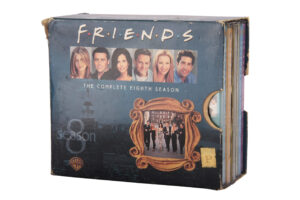The 1990s was a golden age for television, shaping the entertainment landscape with ground-breaking and innovative shows that impacted society. 1990s TV Shows were a diverse range of programming, from gripping crime dramas to relatable sitcoms and everything in between. Major networks, such as ABC, NBC, and relative newcomer Fox, competed for viewers’ attention with their extensive lineups. At the same time, cable channels like HBO and Cartoon Network elevated the industry by exploring bold, fresh concepts.
During this period, popular genres such as sitcoms, dramas, and science fiction garnered immense popularity, captivating audiences and setting the stage for some of history’s most iconic T.V. shows.
Notable series such as Friends, Seinfeld, The X-Files, and Buffy the Vampire Slayer dominated ratings and cultural discourse. At the same time, networks like HBO led the charge in revolutionizing T.V. technology and distribution.
The decade’s lasting influence can still be felt today, as the television shows of the 1990s not only entertained but also addressed complex topics and social issues, leaving a lasting mark on society.
Through its combination of innovative storytelling, memorable characters, and culturally significant themes, this era has continued to resonate with audiences even decades later.
Key Takeaways
- The 1990s introduced a diverse range of groundbreaking T.V. shows that are influential today.
- Popular genres such as sitcoms, dramas, and science fiction dominated the decade, with notable series capturing viewers’ hearts.
- The impact of 1990s television can still be observed in modern programming, technology, and the cultural landscape.

Popular Genres
Sitcoms
In the 1990s, sitcoms were a staple of television, bringing laughter and entertainment to millions of households.
Shows like Friends and Seinfeld quickly became cultural phenomena, as viewers tuned in weekly to catch up with their favorite characters. Sitcoms of this era were often centred around a group of friends or family members and their everyday lives, with humor stemming from relatable situations and witty dialogue.

Dramas
Dramatic television also experienced a renaissance in the 1990s, as networks produced various critically acclaimed series.
Twin Peaks was a groundbreaking’90sw in the early ’90s, blending mystery, horror, and film noir elements.
Medical and legal dramas, such as E.R. and Ally McBeal, captivated audiences with intense storylines and well-developed characters.
These dramas provided an escape from reality for viewers, immersing them in complex narratives and emotionally engaging situations.
Reality T.V.
The 1990s also saw the rise of reality T.V., as producers sought to capitalize on the public’s interest in real-life stories.
Early examples of this genre include The Real World and Road Rules on MTV, which captured the lives of young adults living together and facing various challenges.
These unscripted programs provided a glimpse into the lives of everyday people, generating fascination and sometimes controversy due to their candid portrayal of participants’ experiences.

Animated Series
Lastly, animated series were popular during the 1990s, appealing to children and adults.
The Simpsons became a cultural touchstone, using humor and satire to comment on contemporary society.
Other animated shows, like South Park, Beavis, and Butt-Head, targeted more mature audiences with their edgy, often controversial content. Meanwhile, children’s programming, such as Rugrats and Hey Arnold!, offered fun, engaging stories with memorable characters that remain beloved by many to this day.
Notable Shows

Friends
The sitcom Friends aired from 1994 to 2004. It follows the lives of six friends living in Manhattan, navigating through the ups and downs of their personal and professional lives.
Now considered a classic, the show enjoys a large and loyal fan base.
The ensemble cast, including Jennifer Aniston, Courteney Cox, Lisa Kudrow, Matthew Perry, Matt LeBlanc, and David Schwimmer, created unforgettable characters that have left lasting impressions in the world of television.

The X-Files
During the 90s, The X-Files became a cultural phenomenon.
This sci-fi drama series, which began in 1993, focused on FBI agents Fox Mulder and Dana Scully as they investigated unsolved cases with paranormal or extraterrestrial elements.
The show’s mystery, horror, and science fiction blend provided a unique and engaging viewing experience.
Its popularity propelled the careers of stars David Duchovny and Gillian Anderson.
Seinfeld
Seinfeld, often regarded as one of the greatest T.V. shows in history, premiered in 1989 and aired until 1998.
Created by and starring comedian Jerry Seinfeld, the show was centered around the daily lives of four friends living in New York City.
The show’s unique humor, derived from focusing on the minutiae of everyday life, spawned memorable catchphrases and iconic episodes such as “The Soup Nazi” and “The Contest.” The ensemble cast of Jerry Seinfeld, Jason Alexander, Julia Louis-Dreyfus, and Michael Richards became famous for their distinct and quirky characters.
The ensemble cast of Jerry Seinfeld, Jason Alexander, Julia Louis-Dreyfus, and Michael Richards became famous for their distinct and quirky characters.

ER
The medical drama E.R. debuted in 1994 and continued for 15 seasons. It followed the lives of doctors, nurses, and patients in a Chicago emergency room, providing viewers with an intense, realistic portrayal of the situations and decisions healthcare professionals face daily.
Its ensemble cast included notable actors like George Clooney, Noah Wyle, and Julianna Margulies.
E.R. earned substantial critical acclaim and various awards throughout its run, solidifying its place as one of the most influential dramas of the 1990s.
Influential Networks
NBC
In the 1990s, NBC was a powerhouse in television programming, delivering a “variety of “hit shows to its audience.
The network popularized the “Must See T.V.” programming block, successfully targeting sitcom lovers who tuned in for iconic shows like Friends and Seinfeld.
In addition to comedies, NBC was known for its highly-rated dramas like E.R. and Law & Order, which signifi’90sly impacted the television industry.
ABC
ABC made a mark in the ’90s with several memorable shows that captured the essence of family life.
Notable series such as Full House and Family Matters were staples during the decade, while dramas like NABC’slue pushed the boundaries of traditional primetime television.
ABC’s strong focus on relatable, realistic st’90ss resonated with audiences and helped to shap’90se the landscape of ’90s television.
CBS
CBS also contributed to the ’90s television scene, delivering a mix of family-oriented sitcoms like Everybodynetwork’symond and dramatic series such as Touched by an Angel.
The network’s strength was in its appeal to a wide range of demographics, thanks to shows like Chicago Hope, which catered to fans of dramas and viewers inte’90sed in the medical field.
FOX
As a relatively new network in the ’90s, FOX set itself apart with an arsenal of groundbreaking shows. Popular series like The X-Files and The Simpsons helped establish FOX’s identity by offering unique content and storylines that attracted a loyal fan base.
The network also America’sted with reality television, launching shows like Cops and America’s Most Wanted, which proved successful and further diversified its programming lineup.
T.V. Technology and Distribution
In the 1990s, television technology experienced significant advancements, increasing programming variety and distribution methods.
Networks such as ABC and NBC focused on developing innovative scripted shows and realistic dramas that would captivate audiences.
The 1990s also saw the growth of newer networks like Fox, which became known for its groundbreaking content.
During this time, cable networks like HBO and Cartoon Network began investing in high-quality programming, a turning point in television history.
The widespread adoption of cable television services allowed viewers to access a broad range of channels, further diversifying the T.V. landscape.
The technology behind T.V.s also evolved as large cathode ray tube (CRT) monitors started being replaced with more compact and energy-efficient alternatives.
While flat-panel T.V.s were not yet mainstream, the development of these devices laid the foundation for the future of T.V. displays.
Another significant change in the 1990s was the introduction of digital satellite services, revolutionizing T.V. distribution.
Satellite T.V. allowed viewers to receive hundreds of channels, often with better reception and imagery than traditional cable providers.
This also expanded the reach of television content to remote and rural areas, improving overall accessibility.
The emergence of various mediums like cable and satellite services, along with investments from networks in high-quality programming, helped shape the future of the television industry.
As T.V. technology advances, these innovations from the 90s will always be remembered for their impact on modern entertainment.

T.V. Ratings and Awards
In the 1990s, television saw a surge in popularity and diversity of programming. Shows from various genres garnered high ratings and critical acclaim throughout the decade.
The top-rated primetime television series were measured by Nielsen Media Research, with many memorable shows leading the charts.
Some award-winning 1990s T.V. shows included Seinfeld, Friends, The X-Files, and E.R.
These shows earned high T.V. ratings and were recognized with multiple awards for their writing, directing, and performances by the cast.
For example, Seinfeld won ten Emmy Awards during its nine-season run, while Friends earned six Emmys over ten seasons.
Additionally, shows like The Sopranos and NYPD Blue pushed the envelope in content and storytelling, making them standouts of the decade.
The Sopranos, for example, earned 21 Emmy Awards during its six-season run, while NYPD Blue collected 20 Emmys over its twelve seasons on the air.
Other popular shows of the 1990s spanned various genres, from family dramas like Party of Five to animated successes such as The Simpsons and South Park.
The diversity in programming ensured a broad appeal to T.V. audiences, with many shows earning devoted fan bases and impressive ratings throughout their runs.
In summary, the 1990s was a decade filled with successful and critically acclaimed T.V. shows.
The combination of stellar ratings, prestigious awards, and innovative storytelling solidified the place of these television series in pop culture history.
Cultural Impact
The 1990s was an influential period in television history, with various T.V. shows that left a lasting impact on the viewers and the culture of the time.
One of the primary reasons for this influence was the representation of various social issues and the breaking of traditional stereotypes in mainstream media (source).
Several sitcoms during the ’90s, such as “Friends,” “Seinfeld,” and “The Fresh Prince of Bel-Air,” tackled topics like sexism, racism, and class struggles through humor.
Addressing these issues raised awareness and opened conversations on essential matters, making them relevant today.
Along with these socially-driven narratives, these shows also introduced memorable catchphrases, fashion trends, and iconic moments that continue to’90sact pop culture.
The ’90s also witnessed a surge in quality drama series as HBO and other cable networks began investing in well-crafted, high-production value shows like “The Sopranos” and “The Wire.”
These series broke away from the episodic format and introduced complex, multi-episode story arcs with rich character development.
This new approach to storytelling made T.V. a more immersive and engaging experience, influencing the style of modern television series.
Notably, the representation of racial minorities in television also gradually improved during this period. Shows like “Living Single” and “A Different World” provided better models of African Americans, while “The George Lopez Show” did the same for the Hispanic community.
In summary, ’90s T.V. shows entertained and sparked essential conversations about social issues, representation, and the evolution of storytelling.
This television period has impacted the industry, shaping how content is created and consumed today.
1990s TV Shows Legacy And Nostalgia
The 1990s witnessed a remarkable era of television, with groundbreaking shows that redefined the entertainment landscape.
These T.V. shows left a lasting impact and continue to elicit nostalgia among viewers.
During this time, networks like ABC, NBC, and Fox introduced diverse comedies and dramas that resonated with audiences.
Even cable networks such as HBO and Cartoon Network leveraged quality programming to make their mark in television history1.
One of the most iconic T.V. shows of the 90s is The Sopranos2.
This critically acclaimed drama, which aired from 1999 to 2007, is hailed as a catalyst for the golden age of television.
Its gripping storytelling and memorable performances, notably by the late James Gandolfini, continue to garner appreciation from both new and seasoned viewers2.
Another unforgettable show from this era is Friends3, which chronicled the lives of six individuals navigating careers, relationships, and personal growth in New York Cshow’she show’s relatable characters and humor resonated with viewers, making it one of the most successful sitcoms in history.
Friends remains a nostalgic favorite, with streaming platforms enabling new generations to discover its charm3.
The 90s also saw the advent of genre-defining shows like The X-Files3, which blended science fiction, horror, and mystery elements with compelling storytelling. The show’s success paved the way for similar series with intricate plotlines and dynamic characters3.
The impact of these groundbreaking series can still be felt today, as they evoke nostalgia among viewers while continuing to influence contemporary television.
Frequently Asked Questions
What are some popular sitcoms from the 1990s?
During the 1990s, a variety of sitcoms gained immense popularity.
Some iconic examples include “Friends,” “Seinfeld,” “The Fresh Prince of Bel-Air,” “Frasier,” and “Everybody Loves Raymond.”
These shows focused on humor and relationships and provided valuable lessons while entertaining the audience.
Which 1990s drama series were critically acclaimed?
There were several drama series from the 1990s that received critical acclaim, including “Twin Peaks,” “The X-Files,” “NYPD Blue,” “E.R.,” and “The Sopranos.”
These shows covered various genres, such as crime, mystery, and science fiction, while captivating viewers with engaging storylines and well-rounded characters.
What are the best family shows from the 90s?
The 1990s witnessed some timeless family shows that are still cherished today.
Some well-known family-friendly offerings include “Full House,” “Family Matters,” “Boy Meets World,” and “Sabrina the Teenage Witch.” Additionally, educational programs like “Bill Nye the Science Guy” and “Mister Rogers’ Neighborhood” fostered learning and inspired curiosity in young viewers.
Which 80s T.V. shows continued to be successful in the 1990s?
Several T.V. shows that began in the 1980s saw sustained success into the 1990s, such as “The Simpsons,” “Roseanne,” “Murphy Brown,” and “Cheers.” These programs maintained popularity due to their engaging characters, relatable storylines, and consistent quality.
How does 90s T.V. compare to earlier eras?
The 1990s was a transformative period for television, with significant technological advances and the expansion of cable networks.
As a result, there was a wider variety of T.V. programming catering to diverse interests and demographics.
This era also witnessed the emergence of original content from cable networks, along with more experimental and complex storylines.
What shows from the 1990s are available on streaming platforms?
Many classic 1990s T.V. shows can be found on various streaming platforms. For instance, popular sitcoms like” Friend” and “Seinfeld” can be streamed on HBO Max and Hulu, respectively.
Furthermore, dramas such as” “The X-File” and “Twin Peak” are available on Hulu and Netflix.
These platforms allow viewers to relive their favorite shows, discover new ones, or introduce a new generation to these iconic series.

